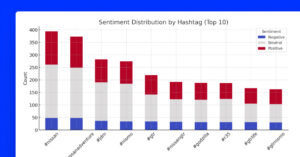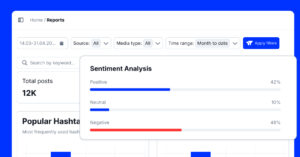Thematic analysis helps uncover patterns in user-generated content—something EmbedSocial supports by turning feedback into actionable themes.
What is thematic analysis?
Thematic analysis is a method used to analyze qualitative data by identifying and interpreting recurring themes or patterns. It’s commonly applied in social research, content analysis, and marketing to make sense of large volumes of text, such as social media comments, customer reviews, and interview transcripts.
‘Thematic analysis’ definition
Rather than quantifying sentiment or assigning scores, thematic analysis explores the why behind the words. As such, it helps uncover insights like brand perceptions, pain points, and unmet needs expressed by users.
Sentiment analysis vs. thematic analysis
Sentiment analysis focuses on detecting emotional tone (positive, negative, neutral) in text, while thematic analysis identifies recurring themes or patterns to understand deeper meanings behind the content.
How thematic analysis works
Thematic analysis starts with gathering a large dataset—like Google reviews or customer comments—and then coding that data to surface recurring themes. Here’s a simplified workflow:
- Data collection – Gather UGC from sources like reviews, mentions, and social posts;
- Initial coding – Tag pieces of text that reflect a particular issue, feeling, or idea;
- Theme development – Group codes into broader themes like “price concerns” or “feature satisfaction”;
- Refinement – Merge or break themes for better clarity;
- Insight extraction – Use the final themes to inform product, marketing, or support decisions.
With tools like EmbedSocial, this process is accelerated—reviews and mentions are automatically collected and filtered, making it easier to tag, sort, and analyze themes at scale.
When is thematic analysis used?
Thematic analysis is most useful when you’re dealing with open-ended, unstructured feedback. Common use cases include:
- Analyzing customer support chat logs to identify friction points;
- Exploring social media conversations to track narrative shifts;
- Reviewing NPS survey comments for recurring concerns.
Steps to perform thematic analysis:
- Familiarize yourself with the data – Read through the content to gain initial impressions;
- Generate initial codes – Highlight key phrases, ideas, or sentiments;
- Group codes into themes – Cluster similar codes to uncover larger trends;
- Review and refine themes – Combine or split themes as needed for clarity;
- Document findings – Present key themes with examples and strategic insights.
Naturally, you can use a third-party social listening platform like EmbedSocial to automate most of the tasks above.
Why thematic analysis matters for marketers
Thematic analysis offers a deeper lens into user perception than sentiment scoring alone. Ultimately, it will help your brand:
- Understand customer motivations and frustrations;
- Adapt messaging based on emerging themes;
- Improve product features based on real-world feedback.
Unlike purely quantitative approaches, thematic analysis captures context, which is vital for customer-centric growth.










